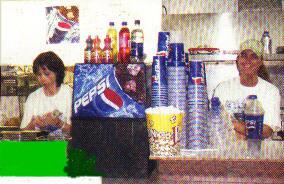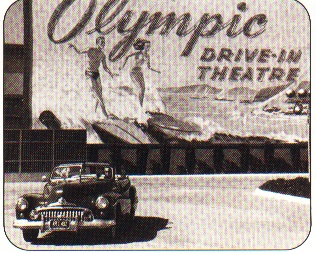 attendance. Concession stands became bigger and faster, adept at serving hundreds of hungry moviegoers during that 10-minute break between features. Regular drive-in goers of the time probably fondly remember the count-down cartoons, with dancing hot dogs that reminded patrons of the time remaining before the start of the second movie. There were other innovations too, like in-car heaters and even mobile concession carts moving from car to car. By the end of the 1950s, there were upwards of 4,000 drive-ins in North America. Scary movies were in vogue, and people flocked to see slithery, slimy, creepy things lurching and looming up there on the big screen. At a time when conventional movie theaters were closing at a rapid rate, drive-ins flourished. Some Trouble But dark skies were on the horizon. Some say that the advent of daylight saving time brought about the decline of America's drive-ins. Seems that a feature film starting at 10 p.m. instead of 9 p.m. made a big difference to parents with little ones in the back seat. And once again, invention and new ways of doing things changed places and people's lives. Cable television, VCRs, land developers and multiple-screen theaters with reclining seats and cup holders came along. One by one, the old drive-ins began to "go dark," many owners selling out to commercial developers. Many giant screens fell to wrecking halls and bulldozers, and by 1990 fewer than 1,000 remained open. The Resurgence Happily, the drive-in saga doesn't end in a pile of rubble. In recent years, something surprising has begun to happen. Some of those old, closed-down places have reopened, and a few shiny new ones have been built from scratch. Patrons don't have to depend on those tinny-sounding speakers, suspended on rickety poles anymore, either. Nowadays, movie soundtracks are broadcast by low range FM radio. | Many of today's drive-ins feature multiple screens and most offer first-run movies. And some concessions offer such gourmet goodies as fried oysters and chicken cordon bleu. Across America, revamped neon signs once again blink their twilight "Welcome," and new, kitschy versions of the dancing hot dog amuse and delight viewers during intermissions. People who haven't been to a drive-in since they were pajama-clad tykes in the back seat of daddy's car are taking their own young families to see first-run movies from the comfort of their SUVs. In Tampa, Fla., one of the hip, young city publications voted the 50-year-old Fun-Lan Drive-In the "Best First Date Destination." In Blue Ridge, Ga., "The Swan,"  another '50s vintage theater, is one of only four drive-ins still operating in the state. Owner Steve Setser started working there when he was only 15. "1 always wanted to see what made it work," he says. Over the years, he worked every job at the theater and finally bought the place. The big single screen, encased in tin, still shows first-run, family friendly movies. "(We) always did," says Setser, "even during the bad years." The Test Of Time It's been quite a journey from Richard Hollingshead's back yard to multi screen venues with FM audio - a journey full of ups and downs. Some of the venerable old drive-ins, like California's handsome Azusa Foothill Drive-In, have even received recommendation for "historic site" status. All things considered, chances are that Hollingshead would be quite pleased that his uniquely American invention has withstood the test of time and change. He'd also be pleased to know that after the sun goes down in communities all across this great country, drive-ins still bring pleasure to so many people in so many places. For a directory listing of drive-ins around the country, check out www.drive-ins.com |
 Film buffs in 1950s Hollywood could take in a movie at the Olympic Drive-In. | |